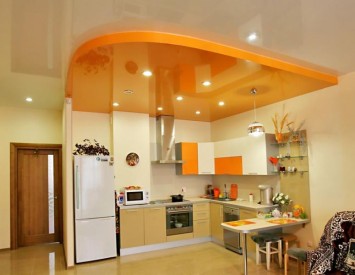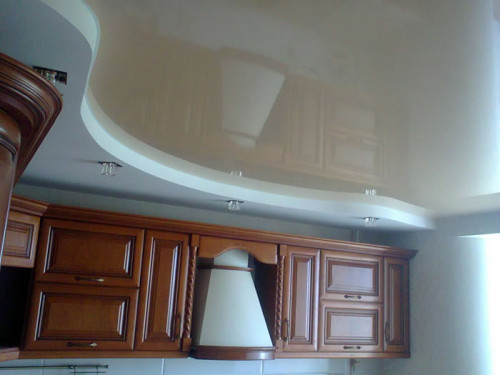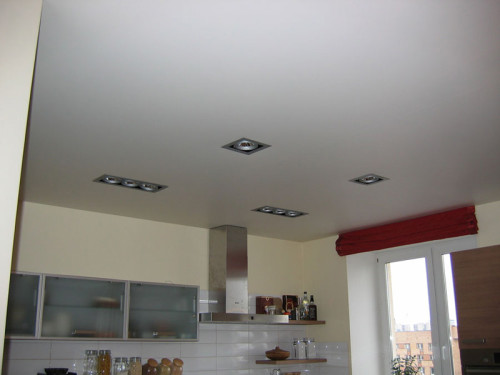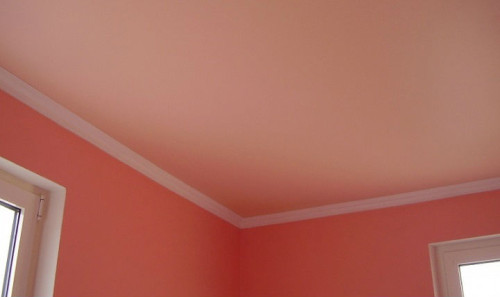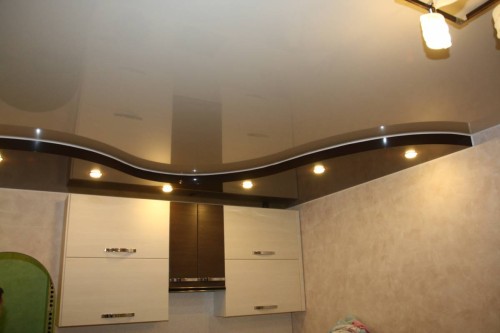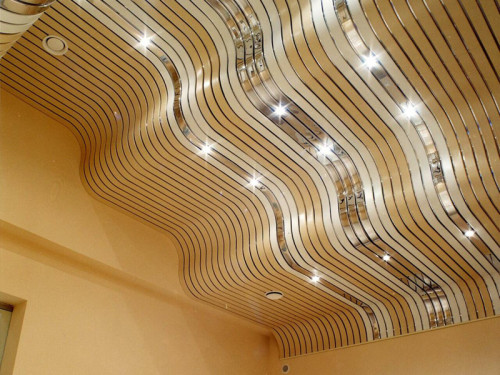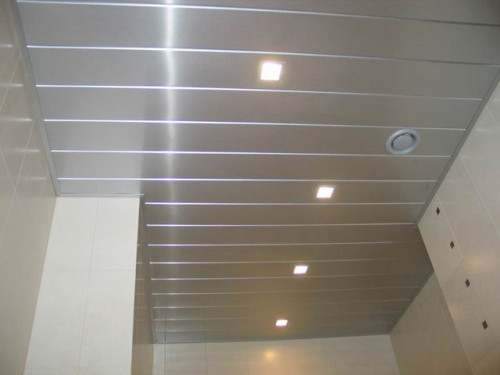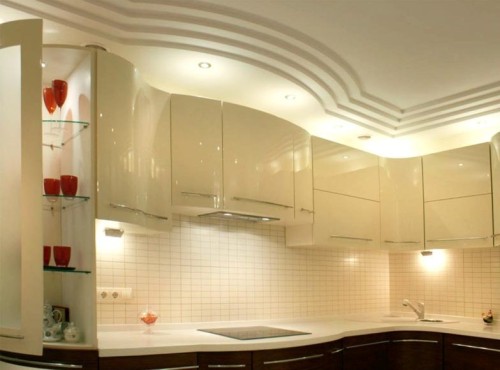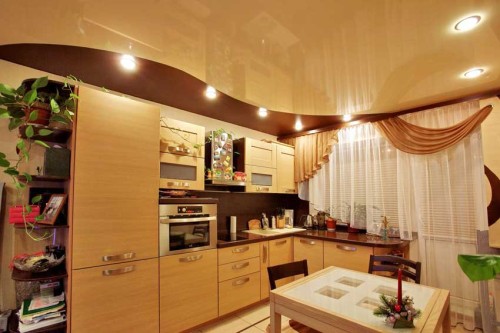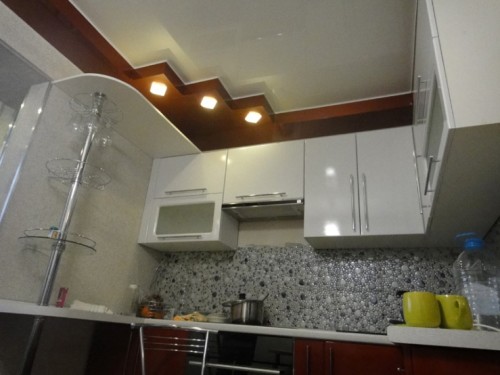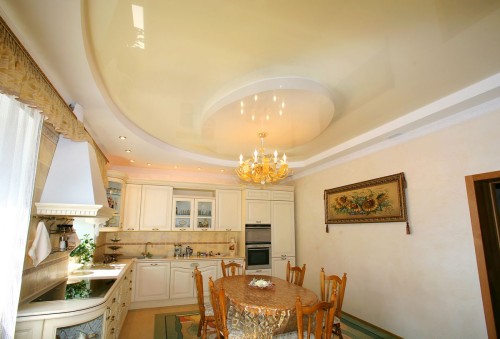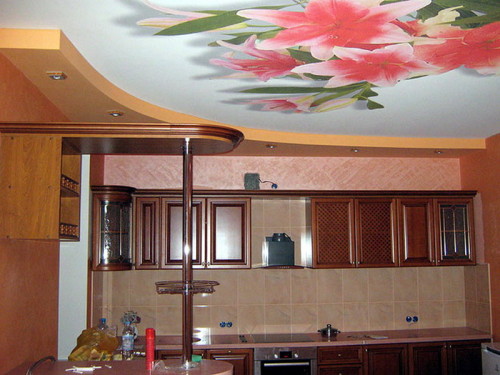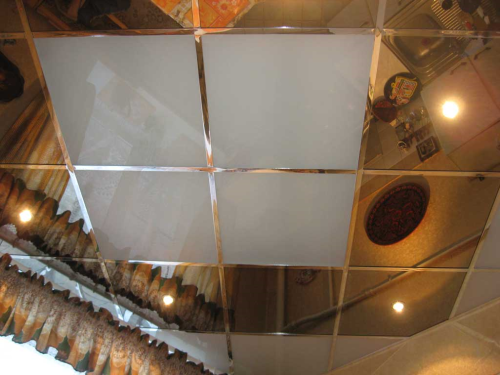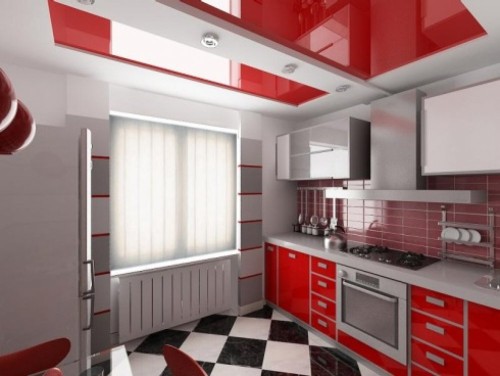An important part of the repair in the kitchen is the ceiling. In this case, the question may arise: which materials are best suited for such work, because the kitchen is a room where not only beauty, but also practicality is important. We will talk about how to make a ceiling in the kitchen in this article.
Content
Features of the kitchen as rooms
The main requirement for living rooms, halls or sleeping rooms is coziness, therefore, when decorating such premises, the main attention is paid to the decorativeness of the materials. The kitchen can be called a kind of working room in which the practicality and wear resistance of the finish rises in the first place. However, like any room in the house, the kitchen should also be designed in a certain style, which should also be taken into account in the process of repair. Before you make the ceiling in the kitchen, you should consider the features of the kitchen as a room and deal with the basic requirements that facing materials must comply with:
- First of all, it is worth noting that the humidity in the kitchen is not only higher than in the rest of the rooms at home, but also often changes. In the process of cooking, a fairly large amount of water evaporates into the environment, which settles with condensate on the walls and ceiling. That is why, as facing materials, it is not recommended to use wood, plywood or MDF - materials that perfectly absorb moisture. From constant getting wet and drying, such a cladding will become unusable in a very short time.
- Temperature drops are another feature of the kitchen room. Especially the difference in temperature in different parts of the kitchen is noticeable in winter, for example, when the window is open to ventilate, and food is prepared on several burners. Given this factor, the material for finishing the ceiling needs to be selected by one that can expand and narrow under the influence of heat and cold, while without losing its strength.
- In the process of cooking food, fat microparticles fall into the surrounding air, which settled with a sticky coating on all available surfaces. Hence another requirement to which facing material should comply with the simplicity of care. The simpler and easier the surface will be washed, the better. Consider also that during the cleaning process you will have to use detergents, so the surface should not enter into chemical reactions with them.
- The facing materials that are used in the decoration of the kitchen should not absorb the smells that are in abundance in such a room.
- Non -smug is another important requirement to which any finishing materials must comply. It is desirable that the cladding is generally unable to catch fire or, in extreme cases, in the process of combustion does not emit toxic components.
- Do not forget about the possibility of flooding, the cause of which can be both leaks on the roof and neighbors from above. In this case, the material that is trimmed with the ceiling may irreparably deteriorate and demand a replacement. To avoid this, it is better to give preference to water -repellent materials.
- Environmental friendliness is another important requirement for materials used in those places where people will constantly be.
- If the finish is planned to be carried out with your own hands, then it is worth selecting a type of facing that you can cope yourself and not attract specialists.
- And, of course, we must not forget about the decorative qualities of materials, as well as the conformity of the chosen option for the overall design of the room.
In addition to all the above requirements, when choosing the type of decoration, attention should be paid to the following factors:
- the area of \u200b\u200bthe kitchen and the height of its ceiling;
- the style in which the room is made;
- the quality of the illumination of the room, the orientation of light, the location of the window.
Simple and inexpensive methods of ceiling finishing in the kitchen
Surgery plastering
Relatively simple in execution, as well as one of the cheapest decoration options, is considered to align the ceiling with plaster and putty. Using such materials, you can create an even surface of a strict laconic type, but you can use decorative plaster compounds and make the ceiling embossed.
Plaster as a finishing material has certain advantages:
- It tolerates moisture differences well, which is a useful feature in the case of the kitchen. Temperature fluctuations also do not have a noticeable effect on plaster.
- Such material does not burn and is safe in case of fire.
- The plaster is environmentally friendly, does not distinguish harmful substances into the environment.
- With the help of decorative surface plaster, you can give any texture, so the material makes it possible to freeze and test yourself as a designer.
The negative qualities of the material include the following properties:
- The plaster is able to absorb water and in case of severe flooding, it will simply move away from the ceiling and disappears. But even if this does not happen, after the flood on the surface, stains are guaranteed to remain.
- Such material also has the ability to absorb odors, which is not very good for the kitchen.
- In addition to smells, the plastered surface absorbs dust and particles of fat, and it is almost impossible to wash it. But with these shortcomings you can fight by additional processing of the plastered ceiling. For example, the surface can be painted with water -repellent paint, which will facilitate the process of caring for the ceiling and make it not so mark.
Painting the ceiling
A simple way to finish the ceiling in the kitchen with your own hands is its coloring. To carry out repairs in the kitchen, the paint should be selected strong, non -toxic, as well as washing. Before painting, the surface should be well prepared. The preparation consists in plastering the ceiling, embarrassing all the cracks and irregularities with putty, wiping the smallest protrusions with sandpaper. It is worth remembering that the paint will not be able to hide the shortcomings of the surface, on the contrary, it will only emphasize the shortcomings, so that the ceiling must be equalized with all responsibility. Of course, such work will require considerable time spent, but financially, painting the ceiling is considered one of the cheapest options.
We will figure out in more detail what colors are most often used for finishing kitchen ceilings:
- Polyvinyl acetate paints have a water solvent in their composition, which makes them environmentally friendly and safe for health. In addition, PVA paints are relatively inexpensive. The minuses of the material include the fact that over time it changes the shade. For example, a white PVA-paint turns in a few years, so the ceiling will require a new repair.
- Acrylic paints based on special acrylic resins are more expensive, but also more durable material. Such a coating does not pass water, does not fade, retains its strength characteristics for a long time. It is worth noting that the color palette in such colors is very wide, so the material is popular among consumers. Acrylic paint can only be applied to the surface if at least 30 days passed after plastering.
- Latex paints have good hydrophobis, they do not miss water at all, so that they can be fearlessly washed. In the process of cleaning, it is also permissible to use detergents and cleaners, because damaging such a surface is quite difficult. Latex paints after drying create a very strong and dense coating, two layers of such a material will be enough to mask small cracks on the ceiling. Among the minuses of such colors, their high cost can be called, but the durability of such a coating should be taken into account. The life of the latex paint is at least 15 years.
- Silicate paints are made on the basis of liquid glass, which makes them strong and absolutely waterproof. In some cases, such paints are used as a waterproofing layer.
- Silicone paints are the most popular material among modern buyers. These paints based on silicone resins are produced. They differ in strength, good water -repellent properties, a long service life, as well as high elasticity. Such a coating is not terrible temperature fluctuations, changes in humidity in the room, prolonged exposure to sunlight. Silicone paints fit perfectly on any surface and after drying form a uniform, dense film. Perhaps the most significant drawback of the material can be considered its high price.
Suspended ceilings as a modern decoration version
Types of suspended ceilings
A characteristic feature of suspended ceilings is that they allow you to hide defects of even the most uneven ceiling. Wood, plastic, PVC film, drywall, metal, etc. can be used as materials for creating suspended ceilings. The operational characteristics of the surface will be due to the properties of the material that was used in the decoration.
All suspended ceilings can be divided into 2 large groups: modular and whole structures. Modular ceilings, in turn, are rack, cassette and lattice. The category of whole includes stretch ceilings and structures made of drywall.
The rack ceiling is a set of long rails, often made of aluminum. This option is the best suited for the kitchen, because such a surface is waterproof, refractory, resistant to pollution, environmentally friendly and easy to care. In addition, the metal surface has a mirror effect, which makes it possible to visually expand the space in a small kitchen. It is difficult to assemble such a ceiling yourself, so you will have to attract specialists.
The cassette ceiling is a design consisting of a frame and modules. To create a frame, metal profiles are used, and aluminum or mineral fiber cassettes are used as finishing material. Mirror or glass cassettes are considered a rare option. Behind the ceiling of this type, you can easily hide not only surface defects, but also various communications. If necessary, individual parts of the ceiling can easily be removed and installed in place. The disadvantage of such a finish is that it conceals a certain space, so it is not recommended to use such structures in the rooms of small area and height.
The lattice ceiling consists of special cells, the back of which is closed by a background substrate. The shape, size and depth of cells in such a ceiling can be different, and the lattices themselves can be painted in any shade.
We will talk more about some types of suspended ceilings further.
Metal ceiling in the kitchen
For such a room as a kitchen, a metal ceiling is considered a very successful solution, because a similar facing material has a lot of positive qualities:
- Aluminum and galvanized steel, which are most often used in such designs, are absolutely not afraid of moisture. S such a ceilings are not afraid of sharp changes in the level of air humidity, as well as direct contact with water.
- Temperature drops for metal ceilings also do not represent any problem. The material is able to expand and narrow from changes in temperature, while without losing its strength.
- Metal is non -combustible material and is absolutely safe in case of fire. In addition, such ceilings are environmentally friendly and do not harm human health.
- Another plus of such designs lies in their practicality. Due to the absence of pores, the metal does not absorb odors, dust, dirt and fat. In case of contamination, the surface can be easily cleaned, using completely any cleaning products.
- Metal ceilings are not afraid of flooding, stains are not formed on them, and the material itself will not suffer at all and will not lose its operational qualities from direct contact with water.
Plastic ceiling in the kitchen
PVC panels are considered popular material for finishing the kitchen ceiling, which, first of all, is due to their affordable cost and ease of installation. Those who do not expect to spend large amounts of money on the ceiling lining, should look at this option. In addition to low cost, plastic ceilings have a number of other advantages:
- PVC panels are not subject to corrosion due to water and high humidity.
- Plastic temperatures are also not a problem.
- Such a surface is easy to care for. It does not absorb dust and particles of fat, and if necessary, it is easily laundered.
- The design weighs quite little, and you can assemble it yourself, without resorting to the help of the masters.
- PVC panels do not burn, but can melt when exposed to fire. At the same time, in the event of a fire, such a material is considered relatively safe, since it does not support combustion and does not emit toxins into the environment.
- Flooding on top of such ceilings is also not terrible, the material will not deteriorate from direct contact with water.
Drywall ceilings in the kitchen
For many years, drywall has been very popular as finishing material. The reason for this lies in its multiple virtues:
- Drywall is easy to work. It is easily cut and even bend, so you can give the material a variety of forms.
- The surface of drywall sheets is perfectly flat. Such a ceiling requires a minimum additional processing, which consists only in the location of the joints between individual fragments.
- Paint, decorative plaster and other finishing materials are perfectly on drywall.
- Such material is considered safe for ecology and does not harm health.
- From drywall, you can make a two -level ceiling in the kitchen, or you can come up with other, more interesting designs.
- Behind the sheets of drywall installed on the frame, you can hide communications and wiring.
- Preliminary preparation of the surface before finishing with drywall is not needed at all. The most important thing in work is to correctly install a frame of metal profiles.
If you are wondering how to make a ceiling in the kitchen using drywall, take into account some recommendations:
- Gypsum cardboard makes it possible to create multi -level structures and give the ceiling various forms. It is thanks to one or another form in the room that certain zones can be distinguished.
- The circle is most often used in order to emphasize the center of the room, the square allows you to zone the kitchen of a narrow layout, and rectangular forms make it possible to hide the flaws of the room.
- If the kitchen has a low ceiling and little space, multi -level structures are better to avoid.
- A single -level drywall ceiling looks restrained, concisely and elegant, and its installation does not take much time and effort.
- In the case of multi -level structures, you will have to attach more efforts, but the design of the room will turn out to be unusual and original. Multi -levelness is best distinguished by contrasting colors and properly selected lighting.
Stretch ceiling in the kitchen
Stretch ceilings always look stylish and expensive. As a rule, they are made of two materials: fabrics or PVC film. Let us consider in more detail the characteristics of each of these types:
- The fabric stretch ceiling has high strength, it is not terrible sharp objects, since even to damage it on purpose is not an easy task. Despite the strength, the fabric can still pass water. In addition, the dismantling of such a ceiling, followed by pulling the same fabric, is impossible, so in the case of flooding on top of the fabric will have to be removed, and then the ceiling is reinstered. The fabric looks very attractive, has a rich assortment of textures, drawings and colors. Such a ceiling looks warm and comfortable, but more suitable for the bedroom than for the kitchen.
- A stretch ceiling of PVC film is considered a more acceptable option for the kitchen, since the film does not absorb moisture and dust, pushes dirt. True, the strength of such material is inferior to the fabric, so that with sharp objects you should be careful. But, if the neighbors are flooded from above, PVC-forth will hold water. Subsequently, it can be carefully drained, and the film is dried and installed in place. By the way, PVC film can withstand at least 60 liters of water per 1 m². A similar material is not only not afraid of moisture, temperature fluctuations are also not afraid of it. The tension ceiling from the film is easy to care for, it can be cleaned using various detergents.
Ceiling in the kitchen, photo:
